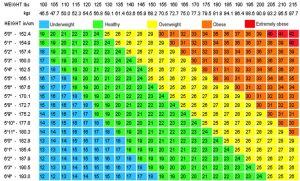BMI (Body Mass Index)
We have all been to the doctor at one point and been told what our BMI is. Do you know what this number means, how it is measured, and its impact? BMI (Body Mass Index) measurements started back in the 1830s by a man named Lambert Adolphe Jacques Quetelet. He was an astronomer, mathematician, statistician, and sociologist and wanted to devise a way to estimate an individual’s obesity levels through a simple mathematical equation. Figuring out your BMI was as simple as taking your weight in kilograms (kg) and dividing them by your height in meters squared (m2). Take me for example:
Weight = 172lbs Height = 69in
172lbs / 2.2 = 78.2kg 69in x .0254 = 1.75m
78.2kg/1.75m2 = 25.47kg/m2
Now, look at the BMI scale and how it brackets scores:

Based on the chart above, I am overweight. Interesting, considering I am someone who exercises pretty intensely 4-6 days a week and eat a pretty healthy diet that is not excessive in calories. This brings us to the draw backs of the BMI scale. The BMI scale was designed to view trends in obesity for a population, not an individual. The BMI scale is great for epidemiologists when they are conducting research and surveys to see how a population is when it comes to overall health. There are correlations with higher BMI and metabolic diseases, cardiovascular diseases, and many others. Many policies and positions have been made by various government agencies and health organizations based on the BMI scale. You’ll see that context is key as we dive into body fat percentage as an alternative measurement.
Body Fat Percentage
Body fat percentage (BF%) is also associated with body composition, but it is much more accurate to the individual. It is simply a measure of fat mass to non-fat mass (this is muscle, bone, organs, and anything else that is not adipose tissue). BF% is measured multiple ways such as the biometric impedance analyzer (BIA) device, skin folds, Dual Energy X-Ray Absorptiometry (DEXA), or underwater weighing, to name a few. As fat has a different density, these measurements use a formula to gain a percentage of your overall body weight and display it as fat. Some are much more accurate than others. (The commercial scales that are available to the public can be up to 8-10% off in error.)
Similar to BMI, higher amounts of fat tissue is correlated to many of the same diseases, but BF% accounts for something the BMI scale does not: lean tissue. For example, my last BF% measurement put me at 13%. So, if we take my weight of 172lbs and multiple it by 13%, we get 22.3lbs of fat. That means I have 150lbs of remaining tissue. Look at this BF% chart:

You can see that based on my age (27) I am in the ideal range for BF%. Now, how can I be ideal BF% but overweight on the BMI scale? The BMI scale does not factor in lean muscle tissue. The BMI scale only takes your weight and divides it by your height. Since I exercise with heavy resistance training, I have more muscle mass compared to a general person, meaning that my weight is going to be higher, pushing me into that overweight portion of the chart.
To sum this all up, both BMI and BF% has relevancy if they are used within their context. BF% tends to be more accurate overall due to its more specific measurement and quantifying for lean tissue compared to the BMI scale. My recommendation is to not worry about the BMI scale so much. If you are extremely obese, then it is a good starting point as a decrease in your BMI score will have direct correlation to your improved health. But as you become leaner, your BF% is a better place to focus. If you have the opportunity, get your BF% checked the next time you can to see your progress or starting point!
